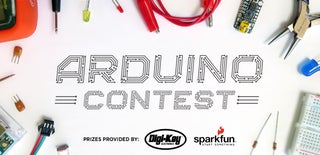Introduction: Pin-Pointer Metal Detector - Arduino
If you are a Metal Detector enthusiast or just looking for a handy workshop tool then you'll like this unique handheld pinpointer for narrowing down the specific location of a metal target.
Using four independent search coils, cool LED colors for signal strength and haptic feedback you can easily discriminate between multiple metal objects.
Step 1: Gather Materials
There are multiple variations of Metal Detector designs. This particular type of metal detector is a Pulse Induction detector which uses separate transmit and receive coils. Note: The circuit has just been simplified to reduce the need for signal diodes and improve sensitivity by employing 2N7000 FET devices on the TX coil.
- Arduino Pro Mini
- USB to Serial Module for Programming the Mini Pro
- LM339 Quad Differential Comparator Integrated Circuit
- Vero Board - 2 pieces (16x11 holes and 34x11) see photo for orientation
- BC548 NPN Transistor x 4
- 2N7000 MOSFET Switch x 5
- Piezo Buzzer
- Coin Vibration Motor for Haptic Feedback
- WS2812 RGB LED Module x 4
- 1k Resistor x 4
- 10k Resistor x 4
- 47 Ohm Resistor x 4
- 2.2K Resistor x 4
- 330pf Ceramic Capacitor
- 0.15uF Polyester capacitors
- Roll of 0.3mm Enamel Copper Wire (normally come in rolls approx 25g Weight)
- Push Button Switch
- 4 x Bamboo Kebab sticks 2mm Diameter
- Electrical Conduit Pipe 20mm diameter length 15cm
- Flexible Electrical Conduit Ducting 32mm Diameter length 15cm
- Electrical Conduit Reducer 25/20mm
- Electrical Conduit Reducer 32/25mm
- Plastic Waste Pipe 32mm Standard Size (32mm inside measurement)
- Electrical Conduit End Stop 25mm
- Waste pipe termination fitting 32mm
- Glue Stick
- Hot Glue Gun
- 2mm and 3mm Drill Bit
- Handheld Drill
- Label Gun or Sticky Tape suitable to label 16 separate wires
- Hookup wire
- 2200mha USB Rechargeable Power Bank
- USB Cable suitable to be modified
Attachments
Step 2: Build Search Coils
The first Photo shows a finished Search Coil with 8 coils and 16 labeled wires extending down the center of the Coil Assembly. This may look daunting however is quite simple as I have provided a template and a method to easily construct.
The first coil is located at the end of the Coil Assembly so that you can pinpoint the target more easily. There are three separate pairs of coils on the side of the Coil Assembly.
1. Prepare the Coil Assembly
Cut a 15cm length of 20mm Electrical Conduit Pipe. Download the template provided, print out on A4 paper and then cut out and glue to the outside of the pipe. Take care to ensure the arrow is at one extreme end of the pipe.
2. Drill the Holes
Use a 2mm drill bit to drill the 16 holes marked on the template for holding the Coils in place. The diameter of these holes should be just big enough to hold a Bamboo Kebab Skewer as per the photos.
3. Channel 1 Search Coil
The first pair of search coils is located at the end of the Coil Assembly so that you can pinpoint the target more easily. This consists of an Outer and Inner coil as per the photo. The inner coil is 12mm diameter wound with 20 turns of copper wire. This is glued into place with hot glue. The two wires are passed down the tube with an additional 10cm length extending past the end of the tube. MAKE SURE YOU LABEL THE ENDS OF THE COILS SO THEY CAN BE IDENTIFIED EASILY WHEN CONNECTING UP TO CIRCUIT BOARD.
The Outer Coil is simply wound around the end of the 20mm Conduit with 20 turns of copper wire and the ends passed through the hole marked on the template.
4. Channel 2-4 Search Coil
The next 3 coils are located on the side of the Coil Assembly. Use 4 Bamboo Kebab Skewers to provide a stable point to wind the coils in place until they are glued and labeled. These are clearly marked on the template and are wound with 20 turns of copper wire then glued into place with hot glue.
Start with the inner coil first so that it won't interfere with the winding process when you come to the next coil.
The two wires are passed down the tube with an additional 10cm length extending past the end of the tube. MAKE SURE YOU LABEL THE ENDS OF THE COILS SO THEY CAN BE IDENTIFIED EASILY WHEN CONNECTING UP TO CIRCUIT BOARD.
Attachments
Step 3: Build the Circuit
The outcome of this step is to produce the two circuit boards ready to connect to the search coils. This consists of two circuit boards to minimise size. I've attempted to provide multiple photos of both sides of each board to enable easier construction. I will attempt to produce a component layout in the next few week.
Step 4: Add LEDs to Coil Assembly
Print out an additional copy of the Coil Assembly template provided and use this as a stencil to get the LED spacing correct. Follow the method in the photos for positioning and carefully soldering the LEDs.
I used a strip of Duct Tape to hold the LEDs in place while cutting and soldering the wires. Take care not to overheat the LEDs and ensure that each LED connection is oriented as per the circuit diagram.
The WS2182 LEDs have a built in IC which enables them to be addressed by the Arduino using three separate wires however a broad range of colors and brightnesses color can be created by sending a command to the LED.This is done through a special library loaded into the Arduino IDE covered in the testing section.
Once the four LEDs are p\lace solder 3 wires for the Data, Positive and Negative connection to the PCB. Drill a 3mm hole in the Assembly and pass this back through the center of the tube as with the other wires. Ensure you label the wires correctly.
Step 5: Preparing the Enclosure
The construction of the enclosure has been made from parts that can be sourced from any good hardware store.
The photos lay out the approach to connecting the enclosure together using the provided materials.
The USB Power Pack is mounted inside the 32mm Tube and held in place with Hot Glue. The position of the USB ports enables you to connect a USB cable to supply the Arduino and at the same time provide access for charging through the removable end cap. See photos.
Step 6: Putting It All Together
1. Physical Assembly
The final step is the connect the circuit boards to the coils, LEDs, Power Pack and Power Switch as per the circuit diagram. The LED and Vibrating motor will not function when connected to the USB as they are powered from the Raw supply. However, this can be tested with the battery connected.
2. Loading Arduino Code and Testing
Before loading the Arduino code you will need to add the Library "FastLED.h" as a library to drive the WS2182 LEDs.
A series of Oscilloscope Traces have been provided for troubleshooting if there are issues.
3. Operating the Unit
The unit operates by calibrating after pushing and holding the power button. All of the LEDs will flash when the unit is ready to be used. Keep the push button down while searching. The LEDs change from Blue-Green, Red, Purple based on strength of target object. The haptic feedback occurs when the LEDs turn purple.
Now go and find some treasure!!

Second Prize in the
LED Contest 2017

Participated in the
Epilog Challenge 9

Participated in the
Arduino Contest 2017















